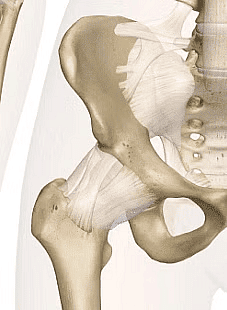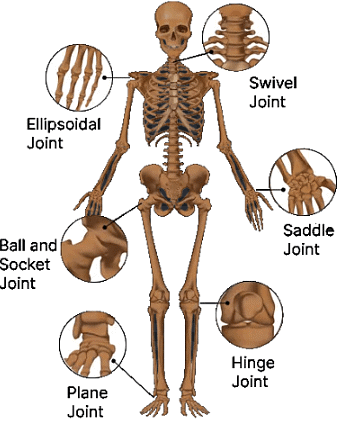Class 6 Exam > Class 6 Notes > Science Olympiad Class 6 > Olympiad Notes: Body Movements
Olympiad Notes: Body Movements | Science Olympiad Class 6 PDF Download
| Table of contents |

|
| Introduction |

|
| Types of joints in Human Body |

|
| Ball and Socket Joints |

|
| Pivotal Joints |

|
| Hinge Joint |

|
| Fixed Joint |

|
| Bones |

|
| Cartilage |

|
| Muscles |

|
| Various kinds of movements in animals |

|
Introduction
- The human body engages in diverse movements during daily activities.
- Hand movements during play, skipping, and exercising, blinking of the eyes, and leg movements while walking or running are common examples.
- Our body can bend and rotate at joints where two bones connect, enabling movement in various body parts like hands, fingers, necks, and legs.
- The focus of this chapter is to explore these joints in the human body and understand their functioning.
Types of joints in Human Body
- The body's bones collectively form a structure known as the skeleton.
- This framework is essential for supporting various organs within the body, enabling activities like standing, walking, running, and other physical movements.
- Different body parts serve distinct functions, leading to varying structures of bones and joints. This diversity is evident when feeling hands, legs, ankles, knees, head, and neck.
- X-ray images of body parts provide a clear view of the bones beneath the skin, offering insights into the skeletal structure.
Different types of Joints
- Ball and socket joints: These joints allow multi-directional movement due to their spherical structure where one bone has a rounded end fitting into a cup-like socket of another bone. They provide a wide range of motion, found in the hips and shoulders.
- Pivotal joints: These joints permit rotational movement along a single axis. They enable rotation or turning movements and are exemplified by the joints in the neck (atlantoaxial joint) that allow the head to turn from side to side.
- Hinge joints: These joints function like a door hinge, facilitating movement primarily in one direction, allowing bending and straightening motions. Common examples are the knees and elbows.
- Fixed joints: These joints are immovable and rigid, providing stability and support to the skeletal system. They are found in the skull, where bones are fused together, ensuring structural integrity and protection for the brain.
Ball and Socket Joints

- This joint type involves a spherical end of one bone fitting into a concave space of another bone, forming a ball and socket structure.
- Movements in multiple directions are possible due to this joint's design.
- Examples include the shoulder joint and hip joint.
Pivotal Joints
- Pivotal joints facilitate various movements such as rotation, twisting, extension, and flexibility.
- The neck joint exemplifies this type of joint, permitting movements of the head in forward, backward, left, and right directions.
- This joint functions akin to a cylindrical bone moving within a ring structure.
Hinge Joint
- Hinge joints exist between two or more bones, facilitating back-and-forth movement in a single plane.
- Examples of these joints include the knees, elbows, and ankle joints.
Fixed Joint
- Fixed joints, as implied by their name, are immovable and do not allow any direction of movement.
- An example is the bones in the skull, which remain stationary and do not exhibit mobility. While the jaw can move, the upper part of the mouth, being part of the skull, remains fixed and immobile.
Bones
- The skeletal framework comprises rigid calcium-based material known as bones.
- An adult human body consists of 206 bones, each varying in shape and size, tailored to serve specific functions within the body.
Various shape and functions of bones
- The chest bone, located at the front, connects to numerous smaller bones at the back, collectively known as the backbone or spinal column. This structure aids in bending forward and backward.
- Ribs, present on both the left and right sides of the chest bone, consist of 12 pairs and collectively form the rib cage. They serve the crucial role of shielding the lungs and heart from potential mechanical damage.
- Below the stomach area, you can feel the pelvic bone, which is the bone you sit on, providing support and structure to the lower body.
- The skull, being the hardest and most durable bone in the body, acts as a protective covering for the brain, safeguarding it from potential mechanical injuries.
Cartilage
- Cartilage, an essential component in the body, contributes to flexibility and resilience. Touching the ear and nose demonstrates its flexibility, as these areas contain cartilage.
- Comparatively softer and more pliable than bone, cartilage is responsible for the flexibility observed in various body parts.
- Cartilage is also present between the joints of the knees and hips, aiding in smooth movement and cushioning the bones during motion.
Muscles
- Muscles, connected to bones, play a pivotal role in human body movement.
- Muscle length changes through contraction and relaxation, enabling various movements.
- When you move your arm, touching your shoulder, you'll notice a bulging part on your arm—this is the muscle contracting. Upon stretching your arm, the muscle relaxes, returning to its normal position.
Various kinds of movements in animals
Various animals possess various kind of movement like swimming, running, jumping, flying, gliding, crawling etc. which is necessary for them to search food and for reproduction. Some of the kinds were discussed below,
Earthworms:
- Found in soil, they feed on dead organic matter and don't have bones.
- Their segmented body moves through alternating stretching and contracting movements, aiding in forward motion.
- Earthworms improve soil fertility by moving through it, eating and excreting undigested material.
Snails:
- Land-dwelling creatures with a wave-like muscular movement.
- They secrete mucus to reduce friction between their bodies and the ground, facilitating movement.
- The shell on their back is not bone and doesn't aid in locomotion; their movement is referred to as crawling.
Cockroaches:
- Terrestrial insects capable of walking, climbing, and flying.
- Body divided into head, thorax, and abdomen, with three pairs of legs in the thoracic part.
- They use the outer hard exoskeleton and breast muscles for wing movement during flight.
Birds:
- Egg-laying animals with feathers, wings, and beaks, capable of various movements like flying, running, walking, perching, and swimming.
- Some, like penguins and ostriches, are flightless; their forelimbs are adapted into wings.
- Hollow skeletons reduce weight, and breastbone muscles power wing movement; heavier bones limit flight capability.
Fish:
- Found in oceans, rivers, and lakes, they swim using a streamlined body shape.
- The tapered body shape aids in easy movement through water.
- Well-arranged skeleton covered with strong muscles; swimming involves body and tail movement, with fins aiding balance.
Snakes:
- Legless reptiles living on the ground, in water, and on trees.
- Their wavy motion involves a long backbone covered with muscles and skin.
- Snakes move through serpentine motion, creating curves in loops for forward movement, but struggle on frictionless surfaces like glass.
The document Olympiad Notes: Body Movements | Science Olympiad Class 6 is a part of the Class 6 Course Science Olympiad Class 6.
All you need of Class 6 at this link: Class 6
|
69 videos|150 docs|104 tests
|
FAQs on Olympiad Notes: Body Movements - Science Olympiad Class 6
| 1. What are the different types of joints in the human body? |  |
Ans. The different types of joints in the human body are ball and socket joints, pivotal joints, hinge joints, and fixed joints.
| 2. What is the function of cartilage in the joints? |  |
Ans. Cartilage acts as a cushion between the bones in a joint, providing smooth movement and reducing friction. It also helps absorb shock and distribute pressure evenly across the joint surface.
| 3. How do muscles contribute to body movements? |  |
Ans. Muscles are responsible for creating movement in the body. When muscles contract, they pull on the bones, causing them to move. Muscles work in pairs, with one muscle contracting while the other relaxes, allowing for coordinated and controlled movement.
| 4. What are some examples of movements in animals? |  |
Ans. Examples of movements in animals include walking, running, flying, swimming, crawling, jumping, and climbing. These movements are essential for various functions such as finding food, escaping predators, and reproducing.
| 5. What is the function of fixed joints in the body? |  |
Ans. Fixed joints, also known as immovable joints, allow for no movement between the bones they connect. These joints provide stability and support to the skeletal system. They are commonly found in the skull, where the bones are fused together to protect the brain.
Related Searches





















